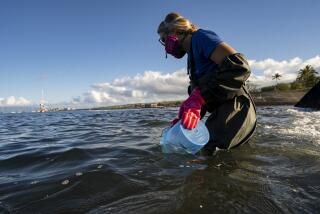Rafting ants use babies as floating life-preservers during floods
When facing oncoming floodwaters, ants use their helpless babies as floating life-preservers – by sticking them at the very bottom of the life rafts that they build with their own bodies.
The findings, described in a paper published in PLOS One, reveal that ant-rafts have a fascinating internal structure – one that maximizes the group’s buoyancy and thus, their chances of survival. But it does so by putting the young ant brood at the very bottom of the boat, exposed to hungry fish and the potential risk of drowning.
“It was an interesting contribution. No one had really looked at this idea of the brood as a flotation device,” said David Hu, a mechanical engineer at the Georgia Institute of Technology who was not involved in the study. “It adds a level of sophistication to the rafts that was previously not understood.”
Researchers have long marveled at the incredible organizing powers of ant colonies. Like beehives and termite nests, these so-called super-organisms exhibit what’s known as “swarm intelligence,” able to act quickly in coordinated ways.
Ants may be tiny alone, but they’re a formidable foe in large numbers. They build bridges with their bodies that others can then walk over, they surround intruders and “microwave” them to death with their body heat, and when a flood hits they can link up and form “rafts” that can float to higher, drier ground. One study even found that the invasive fire-ant Solenopsis invicta actually traps air pockets to form a protective layer that helps keep them afloat.
But researchers at the University of Lausanne in Switzerland wondered if there was even more complex organization to these ant rafts. After all, who were the unlucky ants forced to the bottom of the raft? Was there a reason they were chosen for the job? Were they submerged underwater, and thus at higher risk of drowning?
The researchers also wondered whether the ants would place the most valuable or vulnerable members, like the queen and the young brood, away from the water. The queen is important because she’s the mother of the colony, and the brood – made up of young ants in larval or pupal form, unable to fend for themselves – can’t really move around on their own and likely require extra protection.
To test their hypothesis, the scientists went to Formica selysi ant colonies along the bank of the Rhone River and picked up a bunch of worker ants, brood ants and queens. They took them back to the lab, put them in groups of 60 workers with queens and gave some of them 10 young brood ants to care for. That’s when they started to slowly raise the water level, and watched how these mini-colonies reacted.
Sure enough, the worker ants placed the queen in the center of the ant raft, protected from the water on all sides. But, to their surprise, the ants took the young, helpless brood – the larval and pupal ants — and lined their bodies along the base of the raft, where they’d be most exposed to the water.
This seemed counterintuitive; shouldn’t the ants try to protect their young? After submerging both adult ants and their brood young in the water, the scientists found that the pupae and larvae were actually more buoyant than the adults.
This played out in the overall success of the brood-bottomed rafts, which seemed to do better than rafts held together only by adult worker ants. Once the rafts disembarked, the ant rafts with no brood took less time to disassemble, but they had more ‘nonresponsive’ workers that needed reviving, the authors found. The rafts with brood, on the other hand, took a little more time to disassemble, but there were far fewer on their crew who needed CPR.
There were a few caveats, Hu pointed out: for example, their lab rafts were far smaller than those in the wild, which can carry a whole colony of 100,000 or so members. And ten brood for 60 adults was a pretty high ratio for an ant colony, he added.
Still, the research gives insight into how ants play to each of their members’ strengths. The adult ants link jaws to limbs and move around to give the raft its structure; the brood can’t move, but their buoyant bodies (perhaps because they have more fat content, Hu said) help keep everyone afloat.
The ant young seemed to suffer no long-term ill effects from being put to work like this, the researchers found: They successfully reached adulthood at the same rate as brood that weren’t rafted.
ALSO:
Real glass that bends without breaking? Secret lies in mollusk shells
Watch! Robot termites build complex structures with amazing simple rules
Could future spaceships be built with artificial bone?
The secret of dolphin speed? It’s not skin-deep, scientists find
Why do birds fly in a V? Endangered ibis reveals incredible secret







